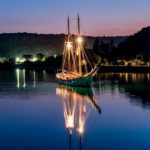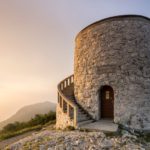One of the most important and most durable symbols of Đakovo and the Đakovština area are horses, which have been bred for more than five centuries on the famous Stud Farm in Đakovo – now the State Stud Farm.

The Stud Farm was founded by bishops of Bosnia and Đakovo on the estates they were given by the deed of donation of Coloman, King of Hungary and Croatia in 1239. The year 1506 is regarded as the beginning of the State Stud Farm because, in that year, the stud farm was first mentioned in connection with the bishop of Đakovo of that period, Mijo Kesarić, who bred around twenty Arab horses. The Stud Farm had probably existed before the first written accounts, most probably, as Dr. Andrija Šuljak assumes, as early as the period of the Crusades.
Horses and Đakovo are mentioned in the same context for the first time in the documents pertaining to the matrimony of the Bosnian ban Tvrtko and the Bulgarian princess Dorotea. Ban Tvrtko gave bishop Petar, the bishop of Bosnia and Đakovo, ten Arab mares and one stallion as a gift.
Up until 1806 only Arab horses were bred in Đakovo. The Stud Farm Lipica fled with 300 horses in that year before Napoleon’s army and settled on the bishop’s farm at Vitika, where they stayed for more than a year. Upon the departure of the Lipica stud farm, three Lipizzan breeding stallions were introduced into the breeding.
When J. J. Strossmayer became appointed bishop in the middle of the 19th century, the transition to breeding exclusively Lipizzan horses was made. “Bishop Strossmayer told his clerks: ‘We will either foster our stud farm properly or we can disperse it’” archbishop Marin Srakić wrote in his text dedicated to the 500th anniversary of the State Stud Farm.
Bishop Strossmayer’s contemporaries followed his advice and the Stud Farm developed and expanded its capacities, and since 1854 only Lipizzan horses have been bred.

At the beginning of the 20th century the Stud Farm had 288 horses and bishop Ivan Krapac built the estate named after him Ivandvor near Đakovo. After World War II the State Farm was nationalized and it has been state property ever since. Queen Elisabeth II visited the State Stud Farm with her husband and royal entourage in 1972 as a part of her formal visit to the SFRY, and in 2016 hosted for the second time a member of the British royal family, Camilla the Duchess of Cornwall.
Stallions are situated at the Stallion station location of the Stud Farm, in the center of the Town of Đakovo. They undergo dressage and training for equestrian sports, therapeutic riding, two-horse, and four-horse carriage riding and riding school. Due to its attractiveness, the activities of Stallion station bring domestic and foreign tourists in large numbers, approximately 20 000 visits per year.

What is also interesting to visitors are numerous expert registers, original pedigrees of the most valuable studs, and hundreds of gold and silver trophies won by the Đakovo horses at numerous competitions, all of which are within the Stallion station offices.
The newly built manege is the center of all activities at the Stud Farm Đakovo either when it comes to horse shows, cart pulling and dressage competitions, hurdle races, and other social events.
Ivandvor is the second location of the Stud Farm where the stud herd of mares with their foals are situated and where they are raised up to the age of three when the colts are taken for dressage and training at Pastuharna.

The horse stables and apartments for workers at the Stud Farm, at the location of Ivandvor, were built in late 1912 by bishop Ivan Krapac. Their authentic shape and form have been preserved to present day and together with an astonishing landscape and serene silence that surrounds the horses to invigorate the body and mind of its visitors.
The importance and beauty of Ivandvor were also recognized by the Ministry of Culture of Croatia which proclaimed Ivandvor to be a cultural heritage site of the Republic of Croatia in 2015.
Author: www.tzdjakovo.eu
Photography: Silvija Butković





